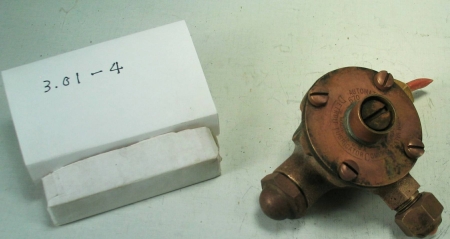Refrigerant Flow Controls – Household
An early, compact, spring compensated, adjustable, automatic expansion valve for use on “dry evaporators”, made by arguably the leader in the technology of the period, Detroit Lubricator, with heavy cast brass body, brass bellows, screw shaft adjustment seal and inlet filter screen, engineered for sulphur dioxide refrigerant, Model 670, Detroit Lubricator, circa 1932.
Removable liquid line inlet screen
Technical Significance:
The Detroit Model 670 would proceed the 672 [see ID # 169 and 170], equipped with bellows adjustment stem seal and beautifully machined brass body, it would no doubt prove to be a costly device to produce.
An example of the new generation of compact, more precisely engineered and performing expansion valves emerging early in the 1930’s, used to maintain cooling units [evaporators], in mechanically cooled refrigerators, at the desired refrigerant pressure.
Dramatises the major gains made by the industry over a period of less than 5 years, during a period of feverish research and development using the scant knowledge and experience available to workers in the field at the time, compare ID # 165 to 168
This artifact of history tells the many stories of early adoption of this particular fluid flow technology, the automatic expansion valve. After a brief flurry of excitement over the use of more costly and delicate float operated devices, as a more efficient means of flow control, industry engineers would return to the automatic expansion valve in the early 30’s. But by then the automatic expansion valve would be a smaller and much more precisely calibrated and efficient device. While the automatic expansion valve was less efficient in its effective use of evaporator surface than high and low side float systems [See HHCC Series 3.01 artifacts, ID # 175 and 176 for example], it had the advantage of reliability, maintainability and affordability, as well as serviceability.
Industrial Significance:
The engineering sophistication and advancements in manufacturing, assembly and materials utilization, represented here, in contrast to ID # 165-168 stands as a remarkable industry achievement.


